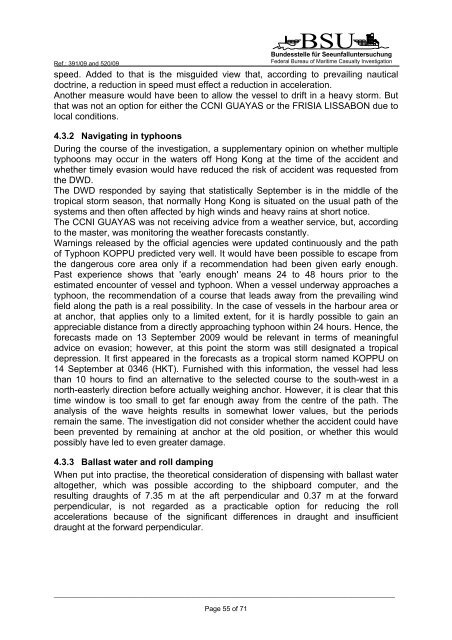SUB-COMMITTEE ON STABILITY AND LOAD LINES AND ON ...
SUB-COMMITTEE ON STABILITY AND LOAD LINES AND ON ...
SUB-COMMITTEE ON STABILITY AND LOAD LINES AND ON ...
You also want an ePaper? Increase the reach of your titles
YUMPU automatically turns print PDFs into web optimized ePapers that Google loves.
Ref.: 391/09 and 520/09<br />
BSU<br />
Bundesstelle für Seeunfalluntersuchung<br />
Federal Bureau of Maritime Casualty Investigation<br />
speed. Added to that is the misguided view that, according to prevailing nautical<br />
doctrine, a reduction in speed must effect a reduction in acceleration.<br />
Another measure would have been to allow the vessel to drift in a heavy storm. But<br />
that was not an option for either the CCNI GUAYAS or the FRISIA LISSAB<strong>ON</strong> due to<br />
local conditions.<br />
4.3.2 Navigating in typhoons<br />
During the course of the investigation, a supplementary opinion on whether multiple<br />
typhoons may occur in the waters off Hong Kong at the time of the accident and<br />
whether timely evasion would have reduced the risk of accident was requested from<br />
the DWD.<br />
The DWD responded by saying that statistically September is in the middle of the<br />
tropical storm season, that normally Hong Kong is situated on the usual path of the<br />
systems and then often affected by high winds and heavy rains at short notice.<br />
The CCNI GUAYAS was not receiving advice from a weather service, but, according<br />
to the master, was monitoring the weather forecasts constantly.<br />
Warnings released by the official agencies were updated continuously and the path<br />
of Typhoon KOPPU predicted very well. It would have been possible to escape from<br />
the dangerous core area only if a recommendation had been given early enough.<br />
Past experience shows that 'early enough' means 24 to 48 hours prior to the<br />
estimated encounter of vessel and typhoon. When a vessel underway approaches a<br />
typhoon, the recommendation of a course that leads away from the prevailing wind<br />
field along the path is a real possibility. In the case of vessels in the harbour area or<br />
at anchor, that applies only to a limited extent, for it is hardly possible to gain an<br />
appreciable distance from a directly approaching typhoon within 24 hours. Hence, the<br />
forecasts made on 13 September 2009 would be relevant in terms of meaningful<br />
advice on evasion; however, at this point the storm was still designated a tropical<br />
depression. It first appeared in the forecasts as a tropical storm named KOPPU on<br />
14 September at 0346 (HKT). Furnished with this information, the vessel had less<br />
than 10 hours to find an alternative to the selected course to the south-west in a<br />
north-easterly direction before actually weighing anchor. However, it is clear that this<br />
time window is too small to get far enough away from the centre of the path. The<br />
analysis of the wave heights results in somewhat lower values, but the periods<br />
remain the same. The investigation did not consider whether the accident could have<br />
been prevented by remaining at anchor at the old position, or whether this would<br />
possibly have led to even greater damage.<br />
4.3.3 Ballast water and roll damping<br />
When put into practise, the theoretical consideration of dispensing with ballast water<br />
altogether, which was possible according to the shipboard computer, and the<br />
resulting draughts of 7.35 m at the aft perpendicular and 0.37 m at the forward<br />
perpendicular, is not regarded as a practicable option for reducing the roll<br />
accelerations because of the significant differences in draught and insufficient<br />
draught at the forward perpendicular.<br />
_____________________________________________________________________________________________________<br />
Page 55 of 71
















